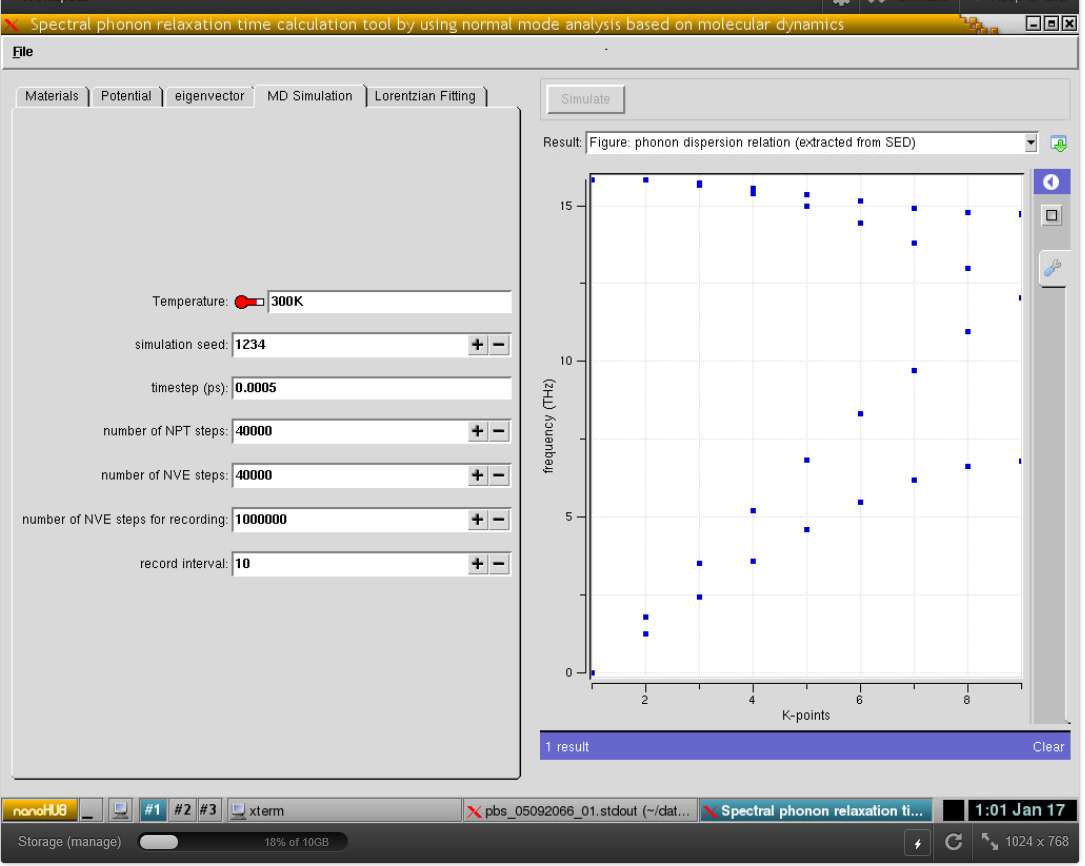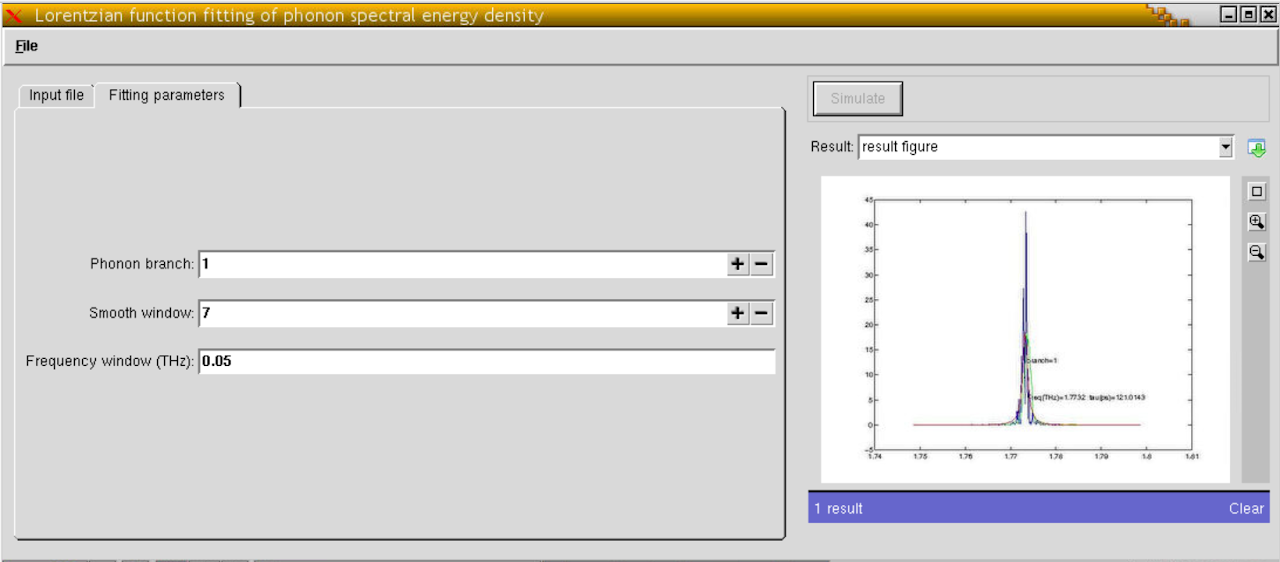Data Library:
Feng’s lab offers machine learning interatomic potentials (MLIPs) that are trained from first principles simulations for free. We kindly request that you cite the corresponding papers from our lab when utilizing our MLIPs.
Thermal barrier coating materials:
La2Zr2O7
Ultra-high temperature ceramics:
ZrC
More content to be added.
Our group have developed programs:
1. Four-Phonon Scattering
Video credit: Linqing Peng (Caltech), Tianli Feng (UofUtah), Xiulin Ruan (Purdue)
FourPhonon: A four-phonon
extension module for
ShengBTE
https://www.shengbte.org/announcements/fourphonon-a-four-phonon-extension-module-for-shengbte
FourPhonon, an extension module to ShengBTE, has been released and is free to download from its GitHub repository: FourPhonon. FourPhonon is a computational package that can calculate four-phonon scattering rates in crystals. It is built within the ShengBTE framework. An adaptive energy broadening scheme is implemented for the calculation of four-phonon scattering rates. In analogy with thirdorder.py in ShengBTE, we also provide a separate python script, Fourthorder.py, to calculate fourth-order interatomic force constants. The extension module preserves all the features of the well-recognized lattice thermal conductivity solver ShengBTE, including parallelism and straightforward workflow. We wish that this program can help researchers explore the four-phonon effects.
Developers:
- Zherui Han (Purdue University)
- Xiaolong Yang (Shenzhen University)
- Wu Li (Shenzhen University)
- Tianli Feng (University of Utah)
- Xiulin Ruan (Purdue University)
Cite: Han, Z., Yang, X., Li, W., Feng, T. & Ruan, X. FourPhonon: An extension module to ShengBTE for computing four-phonon scattering rates and thermal conductivity. Comput Phys Commun 270 (2022) 108179, https://doi.org/10.1016/j.cpc.2021.108179
Phonon is the microscopic heat carrier in solids, and the phonon-phonon scattering is the main thermal resistance mechanism that determines the thermal transport properties of solids.
Four-phonon scattering is a multi-phonon process, and its prediction has been a long-standing challenge for decades. We have solved this problem and found the four-phonon scattering to be of great importance in:
- Low-thermal-conductivity anharmonic materials, such as all ionic crystals, thermoelectric materials, salts, complex oxides, etc.
- Simple crystals with acoustic-optical phonon band gaps
- Most materials at high temperatures
- Optical phonons of most materials
- Materials with reflection symmetry (such as single-layer graphene, BN, CNT)
References:
- T. Feng, X. Ruan*, "Quantum mechanical prediction of four-phonon scattering rates and reduced thermal conductivity of solids", Physical Review B 93, 045202 (2016). [Link] [PDF]
- T. Feng, L. Lindsay, X. Ruan*, "Four-phonon scattering significantly reduces intrinsic thermal conductivity of solids", Physical Review B: Rapid Communications 96 (16), 161201 (2017). [Link] [PDF+SI] (This work is highlighted by several academic news: see our News) (This work is intensively cited by three Science reports: see our News)
- T. Feng, Xiulin Ruan*, "Four-phonon scattering reduces intrinsic thermal conductivity of graphene and the contributions from flexural phonons", Physical Review B 97, 045202 (2018). [Link] [PDF]
- T. Feng*, X. Yang, X. Ruan*, "Phonon anharmonic frequency shift induced by four-phonon scattering calculated from first principles", Journal of Applied Physics 124, 145101 (2018). [Link] [PDF]
- X. Yang, T. Feng, J. Li, X. Ruan, "Stronger role of four-phonon scattering than three-phonon scattering in thermal conductivity of III-V semiconductors at room temperature", Physical Review B 100, 245203, (2019). [Link]
- X. Yang#, T. Feng#, J. S. Kang, Y. Hu, J. Li, X. Ruan*, Observation of strong higher-order lattice anharmonicity in Raman and infrared response, Physical Review B 101, 161202(R) (2020). [Link] (# these authors contributed equally)
- Z. Tong, X. Yang, T. Feng, H. Bao, X. Ruan, First-principles predictions of temperature-dependent infrared dielectric function of polar materials by including four-phonon scattering and phonon frequency shift, Phys. Rev. B 101, 125416 (2020). [Link]
- (Book Chapter) T. Feng*, X. Ruan*, Higher-order phonon scattering: advancing the quantum theory of phonon linewidth, thermal conductivity and thermal radiative properties. in Nanoscale Energy Transport 2-1-2–44 (IOP Publishing, 2020). https://doi.org/10.1088/978-0-7503-1738-2ch2 (invited book) [Link]
- T. Feng*, A. O'Hara, S. T. Pantelides*, "Quantum Prediction of Ultra-Low Thermal Conductivity in Lithium Intercalation Materials", Nano Energy, 104916 , 2020. https://doi.org/10.1016/j.nanoen.2020.104916 [PDF] [SI]
2. ThermoPI
 ThermoPI
ThermoPI
https://thermopi.ornl.gov/calculate
Developers:
- Tianli Feng (ORNL, now at the University of Utah)
- Som Shrestha, Diana Hun, Daniel Howard (ORNL)
- Amit Rai (ORNL, now at University of Dayton)
Thermal insulation materials with ultra-low effective thermal conductivity are critical for a variety of applications such as buildings envelopes, pipelines of oil/water/natural gas transportation, aircraft and re-entry spacecraft, engine and exhaust in automobiles, refrigerators/freezers/tanks, and cold chain systems for vaccines. In the past decades, extensive experimental effort has been devoted to developing new insulation materials with low thermal conductivity, and at the same time, significant effort has been made to improve the theoretical understanding of thermal transport mechanisms in thermal insulation materials and to push the lower limits of the thermal conductivity. However, the thermal conductivity of current insulation materials is still not low enough for many applications. To develop the desired thermal insulation materials, a comprehensive predictive simulation tool is needed to guide the design.
ThermoPI is a free tool that can calculate the effective thermal conductivity as well as the gases, solid, and radiative thermal conductivity components for porous materials. Users need to input the materials' structural information such as porosity, pore size, gas species, pressure, solid species, pore geometry, and temperature. This tool collected and improved the existing theoretical models for gases, solid, and radiative thermal conductivities for thermal insulation materials. These improved models have been validated by our experiment. For solid thermal conductivity, effective medium theory and sound velocity softening effects are considered. The built-in solid materials include polystyrene, polyurethane, polyethylene, and silica. Users are allowed to input their own new solid materials that are not built inside the tool. For gas thermal conductivity, the subcontinuum Knudsen effect is considered. The built-in gases include H2, He, Ne, Ar, Kr, Xe, N2, O2, air, CO2, H2O (water vapor), Ammonia (NH3), Methane (CH4), Propane (C3H8), Acetone (C3H6O), Butane (C4H10), Pentane (C5H12), Sulfur hexafluoride (SF6), Dichlorodifluoromethane (CCl2F2), HCFO-1233zd (C3H2ClF3), and HCFO-1224yd (C3HClF4). Users are also allowed to input new gases. For solid and radiative thermal conductivity calculations, there are several models available to select, and the tool can determine the best model to select based on materials that users input. Users are also allowed to change selections manually. The tool can also calculate the impact of interfacial resistance on the overall thermal conductivity of layered materials.
3. Nanohub Tools
This tool allows users to calculate the spectral phonon relaxation time of most, theoretically all, pristine crystalline solids with available interatomic potentials. It is designed towards a broad application, users can upload any self-defined structures/materials and use this tool to calculate the spectral phonon relaxation time. This tool is not limited to real materials, i.e., users can use this tool to simulate any artificial materials for special purposes. This tool is not only capable for 3D bulk materials, but also for most 1D and 2D materials and nanostructures such as nanowire, nanotube, nanoribbon, 2D sheet, 2D plate, etc. Its key input is the interatomic potential. For the nanostructures such as graphene/BN/MoS2/silicene/black phosphorus nanoribbon, carbon nanotube, Si nanowire, etc., and the complex structures such as Bi2Te3, Bi2Se3, SnSe, skutterudites, etc., the computation may be time-consuming due to the large number of phonon branches. We expect this tool to pave the way towards an efficient investigation of phonon and thermal transport with applications in thermal management and thermoelectric energy conversion.
Cite this tool:
- Tianli Feng, Bo Qiu, and Xiulin Ruan*, Anharmonicity and necessity of phonon eigenvectors in the phonon normal mode analysis, J. Appl. Phys. 117, 195102 (2015).
- Tianli Feng; Xiulin Ruan (2016), "Spectral phonon relaxation time calculation tool by using normal mode analysis based on molecular dynamics," https://nanohub.org/resources/phononlifetime. (DOI: 10.4231/D3DV1CP7R).
This tool was designed for fitting phonon spectral energy, but can be also used for fitting a general data set to get the full width at half maximum (FWHM).
Cite this tool:
- Tianli Feng, Bo Qiu, and Xiulin Ruan*, Anharmonicity and necessity of phonon eigenvectors in the phonon normal mode analysis, J. Appl. Phys. 117, 195102 (2015).
- Tianli Feng; Xiulin Ruan (2015), "Lorentzian fitting tool for phonon spectral energy density and general use," https://nanohub.org/resources/lorentzfit. (DOI: 10.4231/D31R6N21J).
Nanohub tool: Spectral analysis of non-equilibrium molecular dynamics
Developers: Tianli Feng; Yang Zhong, Divya Chalise, Xiulin Ruan (2017)
Cite this work:
- Tianli Feng, Wenjun Yao, Zuyuan Wang, Jingjing Shi, Chuang Li, Bingyang Cao, and Xiulin Ruan, "Spectral analysis of nonequilibrium molecular dynamics: Spectral phonon temperature and local nonequilibrium in thin films and across interfaces", Phys. Rev. B 95, 195202 (2017).
- Tianli Feng; Yang Zhong, Divya Chalise, Xiulin Ruan (2017), "Spectral analysis of non-equilibrium molecular dynamics," https://nanohub.org/tools/spectralnemd (DOI: 10.4231/D3VH5CM12)
This tool allows users to calculate the phonon model temperature and heat flux in nanomaterials, including nano thin films, nanoribbons, nanowires and across interfaces. The prebuilt structures include the Si, Si/Ge interface, graphene, and graphene/BN interface. Users can upload any structures to do calculations. We expect this tool to pave the way towards an efficient investigation of phonon and thermal transport with applications in thermal transport. Please upload the eigenvectors obtained elsewhere (e.g. GULP) by yourself. The MD simulation may take a long time, depending on the domain size and MD steps you assign.



